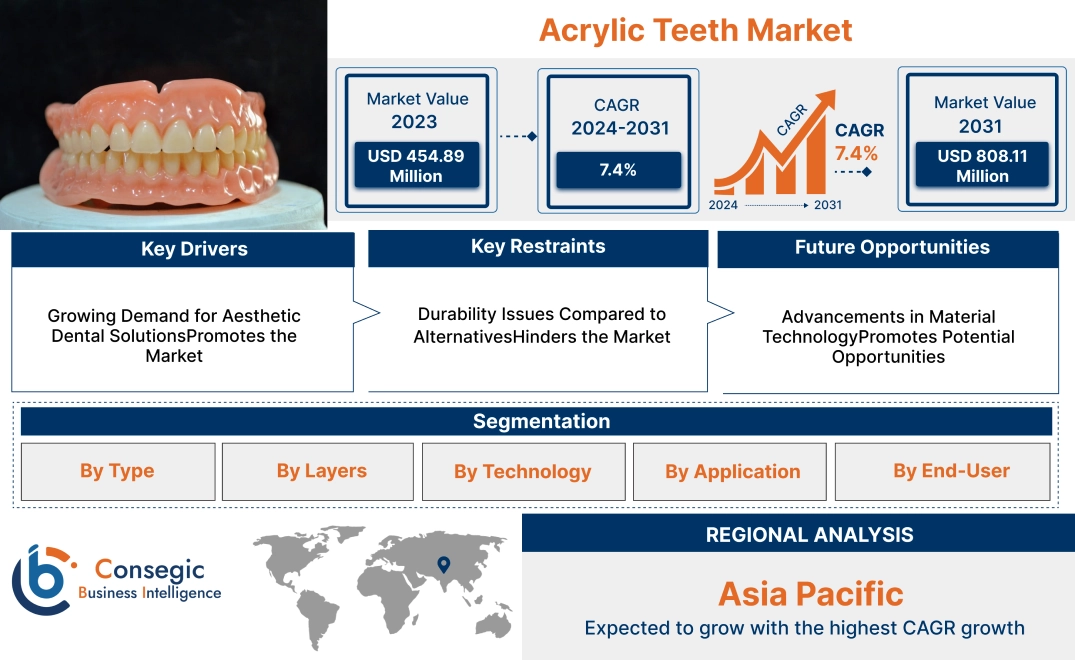- Summary
- Table Of Content
- Methodology
Acrylic Teeth Market Size:
Acrylic Teeth market size is estimated to reach over USD 808.11 Million by 2031 from a value of USD 454.89 Million in 2023 and is projected to grow by USD 480.66 Million in 2024, growing at a CAGR of 7.4% from 2024 to 2031.
Acrylic Teeth Market Scope & Overview:
Acrylic teeth are artificial teeth made from polymethyl methacrylate (PMMA), a type of durable and aesthetically pleasing acrylic resin. These teeth are commonly used in dentures and dental prosthetics due to their natural appearance, lightweight structure, and ease of customization. They offer various benefits, including affordability, ease of repair, and resistance to wear and tear, making them a preferred option for both partial and full dentures. Their versatility allows dental professionals to match them closely to the patient's natural tooth color and shape, enhancing comfort and appearance.
The growing demand for dental prosthetics, coupled with advancements in dental care, is driving the adoption of these teeth in the healthcare sector. Their use is prevalent in dental clinics and hospitals, where they are applied in removable and permanent dental prosthetics. End-use industries such as dental labs, hospitals, and dental clinics are the primary adopters, as acrylic teeth continue to play a key role in restorative and cosmetic dentistry.
Acrylic Teeth Market Dynamics - (DRO) :
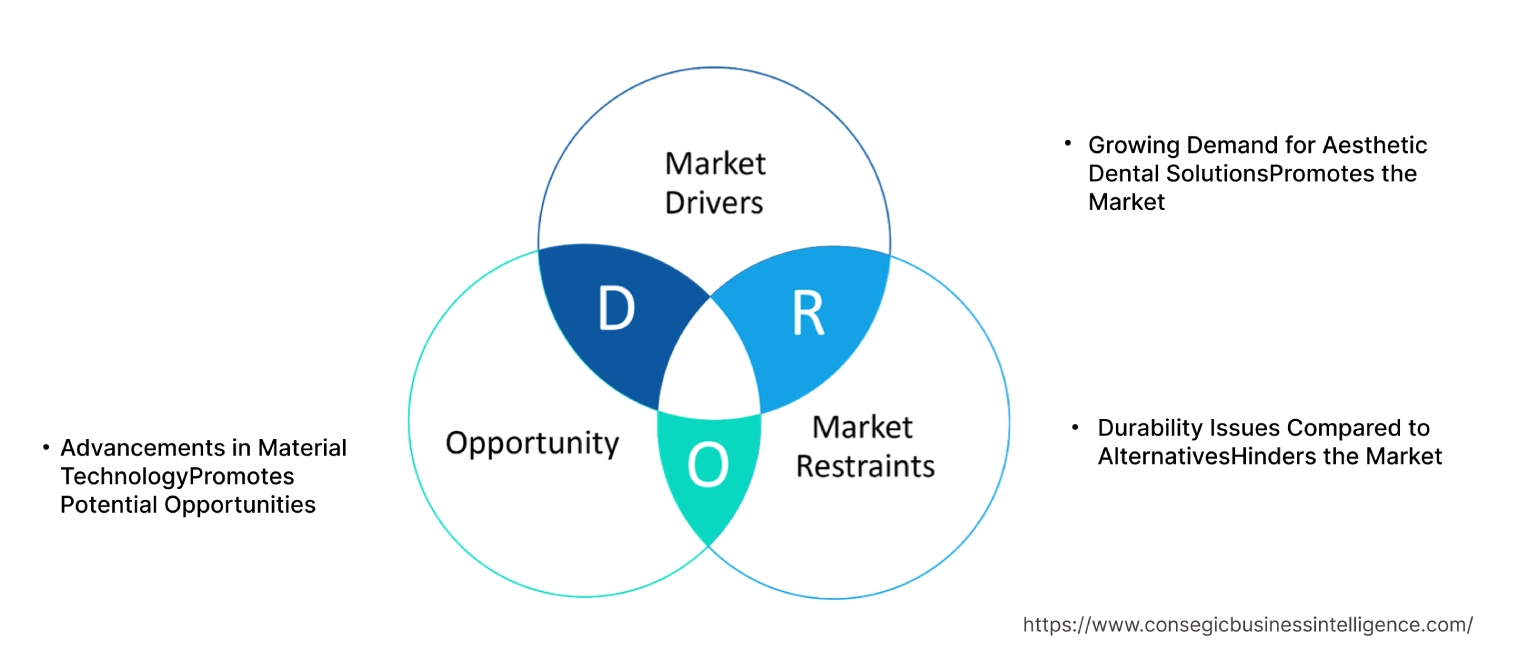
Key Drivers:
Growing Demand for Aesthetic Dental Solutions Promotes the Market
The market is being propelled by the rising demand for aesthetic dental solutions, particularly in the field of prosthetic dentistry. Acrylic teeth are widely used in dentures due to their lightweight, customizable appearance, and cost-effectiveness compared to porcelain alternatives. As the global population ages and cosmetic dentistry trends grow in popularity, the demand for teeth for dentures and partial dentures has surged. Their natural look, ease of molding, and ability to match patient-specific dental shades make acrylic teeth a preferred choice for dental prosthetics, driving acrylic teeth market expansion.
Key Restraints :
Durability Issues Compared to Alternatives Hinders the Market
One of the primary restraints affecting the market is the relatively lower durability compared to porcelain or composite alternatives. While acrylic teeth are more affordable and easier to work with, they tend to wear down more quickly and are more prone to staining over time. This has led some patients and dental professionals to prefer longer-lasting materials, despite the higher cost. The trade-off between affordability and longevity remains a key challenge, limiting the acrylic teeth market growth in segments where durability is a priority.
Future Opportunities :
Advancements in Material Technology Promotes Potential Opportunities
Technological advancements in material science offer significant acrylic teeth market opportunities. Innovations in polymer technology are improving the strength, wear resistance, and aesthetic qualities of the teeth, narrowing the gap between acrylic and more expensive alternatives. Enhanced acrylic materials that resist staining and wear while maintaining cost advantages have the potential to capture a larger share of the market, particularly in price-sensitive regions. Manufacturers that invest in R&D to develop higher-quality acrylic teeth are well-positioned to benefit from these advancements and meet the growing demand for affordable, durable dental solutions.
Acrylic Teeth Market Segmental Analysis :
By Type:
Based on type, the market is segmented into partial denture, complete denture, and overdenture.
The complete denture segment accounted for the largest revenue share in 2023.
- Complete dentures are designed for patients who have lost all their natural teeth in one or both jaws.
- Acrylic-based complete dentures are popular due to their affordability, ease of fabrication, and ability to mimic the appearance of natural teeth.
- They are a critical solution for the aging population, which is facing higher rates of edentulism due to periodontal disease and other dental health issues.
- The segment is driven by the increasing elderly population worldwide, particularly in North America and Europe, where access to advanced dental care is high.
- Additionally, advancements in the aesthetic appeal of complete dentures are enhancing patient satisfaction and contributing to the market.
- Thus, as per the segmental trends analysis, the complete denture segment leads the market due to the rising elderly population and the demand for cost-effective, aesthetically pleasing dental solutions, driving the acrylic teeth market growth.
The overdenture segment is anticipated to register the fastest CAGR during the forecast period.
- Overdentures, which are removable dental prosthetics that fit over remaining teeth or dental implants, offer a superior alternative to traditional dentures by providing enhanced stability and comfort.
- They are increasingly preferred by patients seeking more durable and comfortable solutions, especially in complex cases of tooth loss where some natural teeth or implants can support the denture.
- The rising demand for implant-supported overdentures is driving the segment.
- Additionally, advancements in prosthodontics and growing awareness among patients regarding long-term oral health benefits are boosting the adoption of overdentures.
- Thus, as per the analysis, overdentures are expected to grow rapidly, driven by their enhanced stability and comfort, along with the increasing use of dental implants for superior patient outcomes, boosting the acrylic teeth market trends.
By Layers:
Based on layers, the market is segmented into two-layer, three-layer, four-layer, and others.
The three-layer segment accounted for the largest revenue of 37.53% of the total acrylic teeth market share in 2023.
- Three-layer acrylic teeth are widely preferred due to their balance of durability, aesthetic appeal, and cost-effectiveness.
- These teeth are composed of a base layer for strength, a middle layer for color stability, and a top layer that mimics the natural enamel for a realistic appearance.
- The three-layer structure ensures that the teeth are strong enough to withstand daily wear while maintaining an attractive appearance, making them suitable for full and partial dentures.
- The widespread use of three-layer teeth in dental clinics and laboratories, particularly for high-quality denture applications, contributes to this segment's dominance.
- Thus, the segmental trends analysis shows that three-layer teeth segment leads the market due to its balance of strength, durability, and aesthetic appeal, making it the preferred choice for high-quality dental prosthetics, driving the acrylic teeth market demand.
The four-layer segment is anticipated to register the fastest CAGR during the forecast period.
- Four-layer acrylic teeth offer superior aesthetics and durability compared to two- and three-layer teeth.
- These advanced dental prosthetics are designed with an additional layer to further enhance color gradation, making them nearly indistinguishable from natural teeth.
- The demand for highly aesthetic dental solutions in premium dental care settings is driving the segment.
- As patients increasingly prioritize the natural appearance of their dentures, particularly in regions with high disposable income, the adoption of four-layer teeth is expected to accelerate.
- Thus, the four-layer teeth are set for rapid growth, driven by the rising demand for premium-quality, highly aesthetic dental prosthetics that closely mimic the appearance of natural teeth, boosting the acrylic teeth market trends.
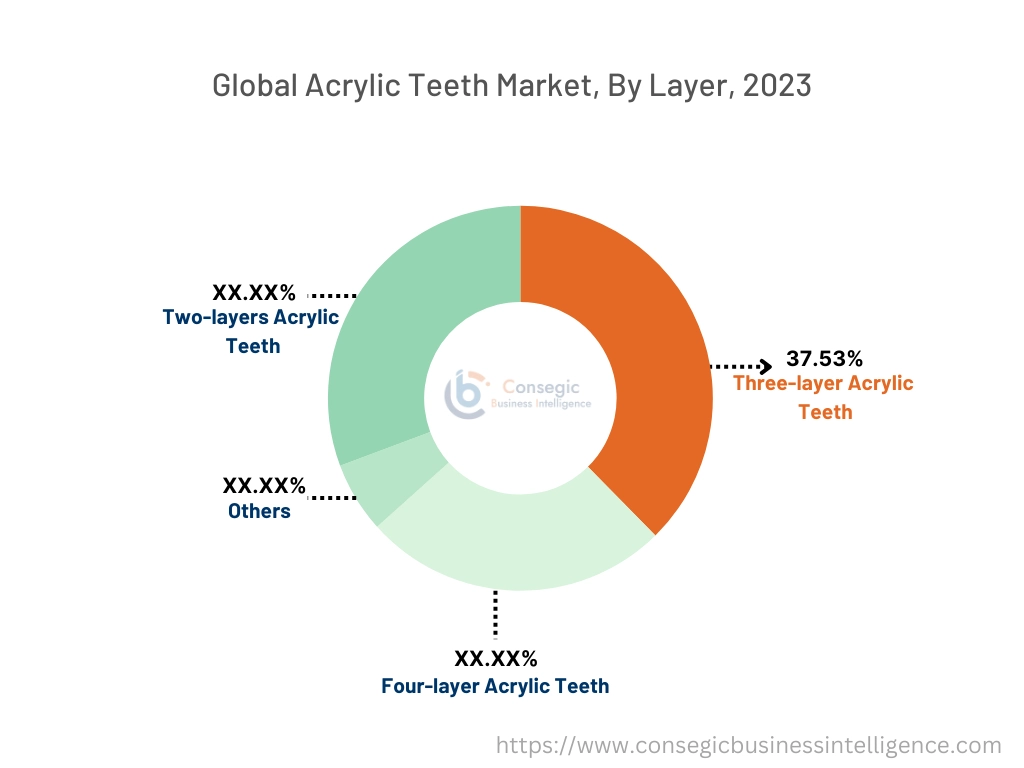
By Technology:
Based on technology, the market is segmented into CAD/CAM and 3D printing.
The CAD/CAM segment accounted for the largest revenue of the overall acrylic teeth market share in 2023.
- CAD/CAM (computer-aided design and computer-aided manufacturing) technology is revolutionizing the production of acrylic teeth by enabling precise design and fabrication of dental prosthetics.
- This technology ensures high levels of customization, accuracy, and efficiency in producing dentures, making it widely adopted by dental laboratories and clinics.
- The use of CAD/CAM technology enhances the overall fit and functionality of acrylic teeth, reducing patient discomfort and improving satisfaction.
- As dental professionals continue to prioritize precision and patient outcomes, the CAD/CAM segment maintains its leadership in the market.
- Thus, the CAD/CAM segment dominates the market as it enables precise, efficient, and highly customizable dental prosthetics, meeting the growing demand for personalized dentures, boosting the acrylic teeth market expansion.
The 3D printing segment is anticipated to register the fastest CAGR during the forecast period.
- 3D printing technology is gaining traction in the dental industry due to its ability to produce highly detailed and customized dental prosthetics quickly and cost-effectively.
- 3D printing allows for the fabrication of acrylic teeth with complex geometries, offering better fit and aesthetic outcomes.
- The growing adoption of digital dentistry and the increasing use of 3D printers in dental labs are driving the segment.
- As 3D printing technologies continue to evolve, their ability to streamline the production process and improve product quality is expected to accelerate adoption.
- Thus, the analysis depicts that 3D printing segment is expected to grow rapidly as advancements in digital dentistry and the demand for highly customized, cost-effective dental prosthetics drive the adoption of 3D printing technologies, boosting the acrylic teeth market opportunities.
By Application:
Based on application, the market is segmented into functionality and aesthetics.
The functionality segment accounted for the largest revenue share in 2023.
- Acrylic teeth are primarily designed to restore the functionality of natural teeth, allowing patients to chew, speak, and smile with confidence.
- In applications where functionality is paramount, acrylic teeth are known for their durability and wear resistance, making them an essential component in full and partial denture applications.
- Patients with complete tooth loss rely heavily on the functional benefits provided by teeth, particularly in older populations.
- The emphasis on restoring essential oral functions drives demand for functional acrylic teeth in various dental care settings.
- The functionality segment dominates the market due to the critical need for durable and reliable acrylic teeth that restore essential oral functions, especially in aging populations.
The aesthetics segment is anticipated to register the fastest CAGR during the forecast period.
- The demand for aesthetically pleasing dental prosthetics is increasing as patients seek solutions that not only restore oral function but also enhance their appearance.
- Acrylic teeth designed for aesthetic applications are typically customized to match the natural color, shape, and alignment of the patient's existing teeth.
- The growing demand for personalized, high-quality dental prosthetics, particularly among younger and middle-aged patients, is driving this segment.
- Moreover, advancements in dental materials and 3D printing technologies are enabling the production of highly realistic, aesthetically superior acrylic teeth.
- The aesthetics segment is expected to grow rapidly as patients increasingly seek dental solutions that combine functionality with enhanced cosmetic appeal, supported by advancements in material science and customization techniques.
By End-User:
Based on end-user, the market is segmented into hospitals, dental clinics, and others.
The dental clinic segment accounted for the largest revenue share in 2023.
- Dental clinics are the primary providers of acrylic teeth prosthetics, catering to patients requiring full and partial dentures.
- The majority of dental procedures involving acrylic teeth, such as the fitting and customization of dentures, take place in clinics.
- As dental clinics increasingly adopt advanced technologies like CAD/CAM and 3D printing, they are able to offer more precise and personalized dental solutions, enhancing patient outcomes.
- The growth of dental tourism, particularly in countries with well-established dental care infrastructure, further drives the demand for acrylic teeth in clinics.
- Dental clinics lead the market as the main providers of acrylic teeth prosthetics, with increasing adoption of advanced technologies that enhance the customization and precision of dental solutions.
The hospitals segment is anticipated to register the fastest CAGR during the forecast period.
- Hospitals and trauma centers, particularly those with specialized oral and maxillofacial surgery departments, are increasingly adopting acrylic teeth prosthetics for patients requiring complex dental restorations following trauma or surgery.
- These facilities cater to a growing number of patients with severe dental injuries or oral conditions that necessitate full or partial dentures.
- The increasing prevalence of dental trauma, combined with the rising number of oral surgeries, is expected to drive the segment.
- The hospital & trauma center segment is poised for rapid growth due to the rising demand for dental restorations in trauma cases and complex oral surgeries requiring acrylic teeth prosthetics.
Regional Analysis:
The regions covered are North America, Europe, Asia Pacific, the Middle East and Africa, and Latin America.
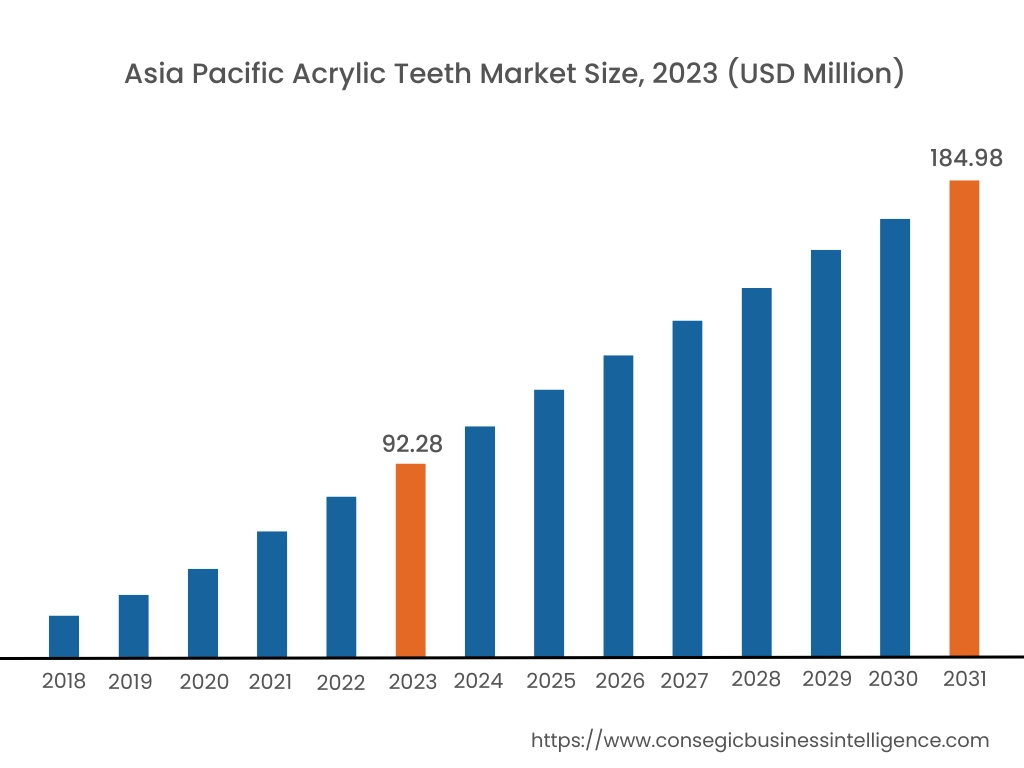
Asia Pacific region was valued at USD 92.28 Million in 2023. Moreover, it is projected to grow by USD 98.55 Million in 2024 and reach over USD 184.98 Million by 2031. Out of this, China accounted for 46.2% of the total market share. As per the acrylic teeth market analysis, Asia-Pacific is the fastest-growing region for the market, driven by rising disposable income, increasing dental care awareness, and the growing elderly population in countries like China, Japan, and India. The demand for affordable dental solutions, such as acrylic teeth, is growing rapidly, particularly in rural areas where access to advanced dental care is limited. Additionally, government initiatives to improve healthcare infrastructure and promote dental health drive market expansion. However, the lack of skilled dental professionals and limited access to advanced dental technologies in some areas hinder full market potential.
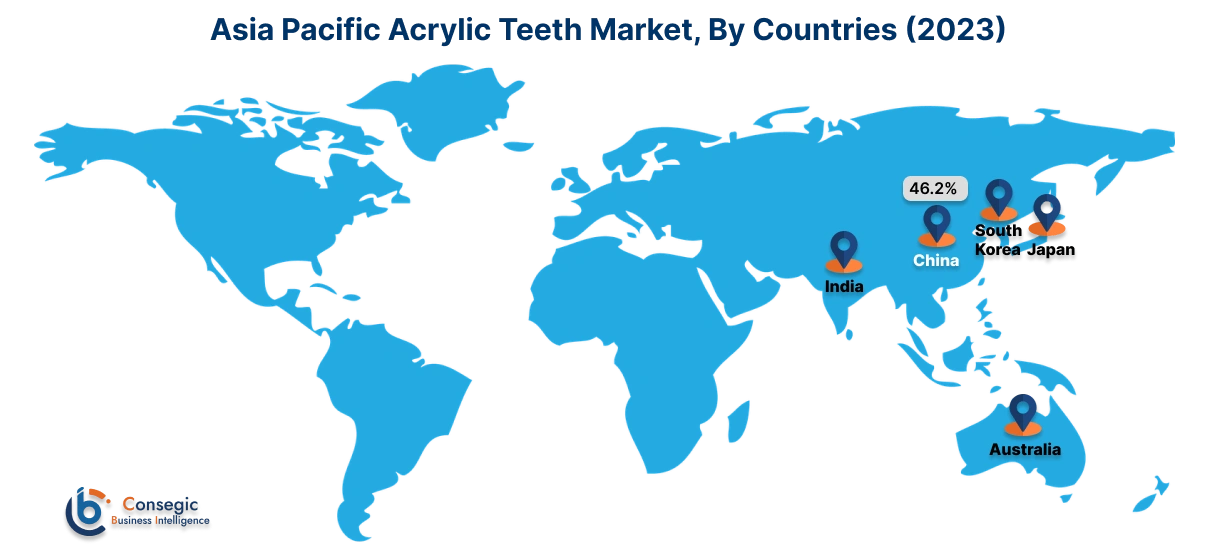
North America is one of the largest markets for acrylic teeth, driven by the high prevalence of dental disorders and the increasing elderly population. The U.S. leads the market, supported by advanced dental care infrastructure and widespread adoption of prosthetics and dentures. Increasing awareness of dental aesthetics and the availability of affordable dental insurance have further propelled market growth. However, rising competition from alternative materials, such as ceramic and zirconia, is a key challenge in this market.
Europe holds a significant stake in the market, with countries like Germany, the UK, and France at the forefront due to their well-established healthcare systems and aging populations. The growing demand for dental prosthetics and dentures, particularly in countries with high elderly populations, drives the market. Increasing awareness of dental care and advancements in dental technology also support growth. However, stringent regulatory policies for medical devices in the European Union and the shift toward more durable materials pose challenges.
The Middle East & Africa market for acrylic teeth is growing steadily, with countries like Saudi Arabia, the UAE, and South Africa seeing increased demand for dental prosthetics due to improving healthcare services and rising awareness of oral health. The focus on expanding healthcare infrastructure in the region has led to increased investments in dental care. However, high costs and limited access to advanced dental procedures in several parts of the region remain significant challenges.
Latin America is an emerging market for acrylic teeth, led by Brazil and Mexico. The market is fueled by a rising aging population, increasing demand for dental prosthetics, and expanding access to dental care services. Brazil's growing dental tourism industry also contributes to market expansion. However, economic instability and inconsistent access to healthcare in some countries may limit market growth.
Top Key Players & Market Share Insights:
The acrylic teeth market is highly competitive with major players providing products to the national and international markets. Key players are adopting several strategies in research and development (R&D), product innovation, and end-user launches to hold a strong position in the global acrylic teeth market. Key players in the acrylic teeth industry include-
- Dentsply Sirona (USA)
- Kulzer GmbH (Germany)
- GC Corporation (Japan)
- Modern Dental Group (Hong Kong)
- Shofu Inc. (Japan)
- Ivoclar Vivadent AG (Liechtenstein)
- VITA Zahnfabrik (Germany)
- New Stetic S.A. (Colombia)
- Yamahachi Dental Mfg. Co. (Japan)
- Mitsui Chemicals, Inc. (Japan)
Recent Industry Developments :
Product Launch:
- In April 2022, Dentsply Sirona introduced Lab Software 22.0, featuring updated CAD and CAM tools with a unified user interface for design and manufacturing, expanded design options, and extended connectivity to CEREC Primemill. This upgrade enhances machine connectivity for users, whether they use Dentsply Sirona or other CAD/CAM systems. Additionally, in September 2021, Dentsply Sirona launched a multilayer graded zirconium oxide block, offering high aesthetics and ease of processing with zirconium oxide's renowned strength.
Partnership:
- In October 2022, Ivoclar announced an expansion of its partnership with Exocad, integrating the Ivotion Denture add-on module into Exocad's DentalCAD software, enhancing digital dentistry processes. Exocad, a major dental software provider, serves a broad customer base and is known for its expertise in dental CAD/CAM solutions.
Acrylic Teeth Market Report Insights :
| Report Attributes | Report Details |
| Study Timeline | 2018-2031 |
| Market Size in 2031 | USD 808.11 Million |
| CAGR (2024-2031) | 7.4% |
| By Type |
|
| By Layer |
|
| By Technology |
|
| By Application |
|
| By End-User |
|
| By Region |
|
| Key Players |
|
| North America | U.S. Canada Mexico |
| Europe | U.K. Germany France Spain Italy Russia Benelux Rest of Europe |
| APAC | China South Korea Japan India Australia ASEAN Rest of Asia-Pacific |
| Middle East and Africa | GCC Turkey South Africa Rest of MEA |
| LATAM | Brazil Argentina Chile Rest of LATAM |
| Report Coverage |
|
Key Questions Answered in the Report
What is the projected growth of the Acrylic Teeth Market? +
Acrylic Teeth market size is estimated to reach over USD 808.11 Million by 2031 from a value of USD 454.89 Million in 2023 and is projected to grow by USD 480.66 Million in 2024, growing at a CAGR of 7.4% from 2024 to 2031.
Why are acrylic teeth preferred over other materials? +
Acrylic teeth are preferred due to their lightweight nature, ease of customization, and affordability. Additionally, they offer better aesthetic qualities and are easier to adjust, making them a popular choice for denture wearers and dental professionals.
Which region is experiencing the highest demand for acrylic teeth? +
North America is experiencing the highest demand for acrylic teeth due to its aging population, rising awareness of oral health, and the well-established dental care infrastructure. The presence of advanced dental facilities and high disposable incomes also contribute to this growth.
What factors are driving innovation in the Acrylic Teeth Market? +
Innovation in the Acrylic Teeth Market is driven by the need for more durable and natural-looking teeth, leading to advancements in material technology. Manufacturers are focusing on improving the strength and longevity of acrylic teeth while enhancing their aesthetic appeal to meet patient demands.
Who are the leading players in the Acrylic Teeth Market? +
Major players in the Acrylic Teeth Market include Dentsply Sirona (USA), Ivoclar Vivadent AG (Liechtenstein), Kulzer GmbH (Germany), GC Corporation (Japan), Modern Dental Group (Hong Kong), Shofu Inc. (Japan), VITA Zahnfabrik (Germany), New Stetic S.A. (Colombia), Yamahachi Dental Mfg. Co. (Japan), and Mitsui Chemicals, Inc. (Japan).
